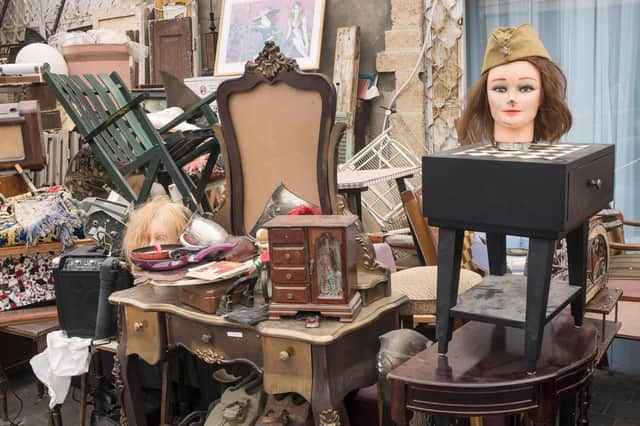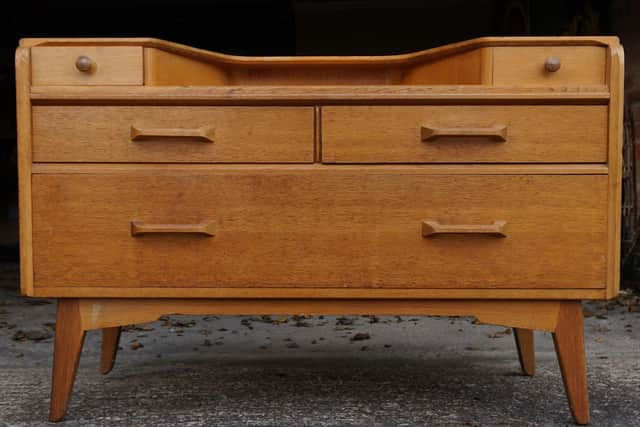Be a real-life Bargain Hunter: How to spot the most valuable antiques


You’ve probably heard of someone who picked up a bargain in an antiques shop or even a car boot sale, only to discover – to their delight – it was actually worth a fortune. So, how can you become one of those lucky souls?
There are no guarantees but with a bit of knowledge, anyone can have a head-start on spotting their own bobby-dazzler – and there’s a new book that promises to help.
Advertisement
Hide AdAdvertisement
Hide AdBargain Hunt: The Spotter’s Guide To Antiques is packed with tips from experts who work on the BBC’s popular Bargain Hunt series, detailing the best ways to identify quality across a range of antiques and younger collectibles – from recognising makers’ marks to tell-tale historical styles.


“There’s so much to learn,” says author Karen Farrington. “Most of us have a feel for particular items – you might have inherited a piece of china from your granny and done a bit of research on it, or you might have inherited a necklace and have learned a bit about jewellery, and there are plenty of guides that will set you up with some degree of knowledge before you start.
“Any expert will tell you the best way to get into something like this is to go and look at an antiques fair, and touch items if you can. Having a little bit of knowledge will feed in to making the right choices.”
She says that with every kind of item, if you’ve got a set – a full set of chairs, a tea set, a set of toys or cigarette cards – they’re much more valuable than if you’ve only got one or two. However, she adds: “But then people like to complete collections [too] and will sometimes pay high prices to obtain an item that will complete their set.”
Here are some of the things to look for…
China
Advertisement
Hide AdAdvertisement
Hide AdBargain Hunt expert Ben Cooper says older British ceramics are expected to bear marks to identify the skill of the maker, but with highly-coveted Chinese porcelain that’s not the case.
“Imperial porcelain might have blue rings on the bottom, or auspicious characters,” he explains. He points out there are many copies of Chinese porcelain on the market, but adds: “A number of original and rare Chinese pieces do turn up in sheds and lofts, so might you have a rare piece of Chinese artwork tucked away at home? The short answer is, yes.”
On a far more mundane but probably much more attainable level, ceramics sets made exclusively for good old Woolworths in the 1950s and 1960s are actually worth a lot of money these days. A set of monochrome Homemaker homeware now commands a very high price – even incomplete sets have a reasonable value, says Farrington. One Bargain Hunter bought a partial Homemaker tea set for £35 and sold it for £50. Farrington says: “A teapot which might have sold for 10 shillings at the time, might be worth as much as £200 today.”
Another type of china to look out for is Royal Worcester painted and signed by artist Harry Davis, who began decorating the china in 1898 aged just 13. Farrington says his work is sought after – on one episode of Bargain Hunt, the expert Philip Serrell spotted a tiny vase signed by Davis and bought it as the bonus buy for £170 (when the expert can use any leftover money from the team’s budget to buy an item to be sold at auction). It sold for £780.
Furniture
Advertisement
Hide AdAdvertisement
Hide AdMany people assume that the older the item, the more value it has – but that’s not necessarily the case. Farrington explains: “On Bargain Hunt, you see time and time again what we know as ‘brown furniture’- old-fashioned or Victorian – which really commands very little value. Contestants think because something’s old, it’s valuable. But sometimes heartbreakingly, it’s old, beautifully designed and very well-made, but still doesn’t command any value. It really does depend on the consumer taste of the day.”
She says a good example of more modern items that have risen hugely in value is 1970s furniture. “I got rid of my parents’ 1970s furniture as quickly as I possibly could, but it turns out that was a mistake,” she says ruefully.
“It depends who made it, where it was made and the design, but 1970s furniture can really be top of the charts in furniture, in a way that something like a Victorian walnut chest just isn’t.”
Farrington says the earliest IKEA furniture is worth a lot these days – which, she notes, “is extraordinary” – as are ubiquitous post-war G Plan pieces, high-quality Ercol timber furniture, and handcrafted vintage Parker Knoll chairs and sofas. “If you get one of those James Bond-style Parker Knoll chairs, that will see you right financially,” she advises.
Glass
Advertisement
Hide AdAdvertisement
Hide AdGlass is “notoriously hard” to value, says Farrington, who points out that glass from the Georgian period can be valuable – although there are fakes around. The real thing is usually grey rather than white, and Farrington says the glass looks smoky when you put white paper behind it.
Also, when they’re pushed together side-by-side, the feet of Georgian glasses normally touch before the bowls do, and the glass may have ‘seeds’ in it because of the way it was made.
Cooper’s advice on buying glass is simple: “Buy what you like, what you are drawn to, and buy what you can afford.”
And Farrington stresses it’s not all about how much money you can make by buying an item. “You should never rule anything out just because you think it’s not going to be worth a great deal,” she says. “Something called carnival glass, which you can get very cheaply at carnivals and fairs, can be very pretty and absolutely hit the right spot when you place it on your mantelpiece or wherever you put it, so why worry whether it’s worth anything?”
Posters
Advertisement
Hide AdAdvertisement
Hide Ad“What’s increasing in value now are things like original film posters – they’re changing hands for a surprising amount of money,” says Farrington, who suggests going to your local cinema and trying to get the latest Bond posters. “Keep them in acid-free tissue to preserve them, and see what happens,” she says.
Toys
“A lot of adults are revisiting their youth by either repurchasing toys they loved and lost, or never had at all,” says Farrington, who explains there’s a huge variety of valuable toys, including Pokemon cards, branded figurines like Buzz Lightyear, and Star Wars toys – a rare rocket-firing Boba Fett figure sold for £18,600 last year.
“If you’ve got a particular toy in your toy box from your youth, it may be worth something, but it probably won’t be, because toys were made to be played with,” says Farrington. “The ones worth huge money are those that not only come in their original packaging, but still have the little holes in the top of the cardboard where they’re put into rows – they’re the ones that are most likely to command huge value.”
Bargain Hunt: The Spotter’s Guide to Antiques is published by BBC Books on July 14, priced £16.99.
Comment Guidelines
National World encourages reader discussion on our stories. User feedback, insights and back-and-forth exchanges add a rich layer of context to reporting. Please review our Community Guidelines before commenting.